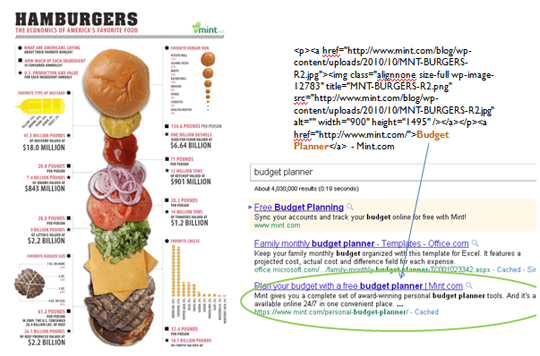Looking to partake in the latest infographic craze? Look no further as you’ve come to the right place. In case you were counting on the rapture and were hiding under a rock for the past, oh two years or so, infographics are simply visual representations of information, data, or knowledge.
Infographics have turned into a widely popular and viral format of link bait because, since no one on the internet reads or has any sort of attention span, they are filled with pictures and easily digestible stats and bullet points.
Search marketers love infographics given their viral nature and inherent link bait abilities. And as social factors are beginning to play a larger role in terms of contributing to how content can rank organically, it has become increasingly important to develop types of content that will motivate readers to hit the Facebook “share” button and tweet out links to their friends.
Mint.com has been hugely successful with the use of infographics as a strategy to gain brand awareness, blog readership, inbound links and better rankings. Over the past couple years they’ve pumped out countless infographics which with the help of Digg.com, have earned them a killer backlink profile with links from the New York Times, Washington Post, CNN.com, Wired, Time, Lifehacker, Business Week, TechCrunch, CNET, Mashable, you name it. Additionally, they’ve been able to obtain top rankings for competitive keywords that have clearly been targeted for SEO purposes.

So how can you translate this into a successful strategy for your business? For starters, you should probably have a blog as this is a natural place for the infographic to live. Next, you need an idea – many, many infographics have already been done.
For example make sure you do a Google search for “green living infographics” before you spend a ton of time and energy to go about creating one just to find out your idea has already been done. There are a few approaches one can take in terms of concept development – either a timely piece based around breaking news (the recent floods, the Charlie Sheen debacle, etc) or a piece that isn’t tied to any current events and will have a longer lifespan. Both of these can be effective, the first will garner a lot of links and visibility upfront whereas the latter will have legs that will likely gain links over a longer period of time.
There are many resources to research different ideas, InformationIsBeautiful.net, Daily Infographic and The Good infographics for example.
Of course, remember to add the snippet of code to allow other bloggers to copy and paste the infographic on their site. Within the code, optimize the anchor text that links back to your post with the keyword you’ve targeted for SEO (see above example with Mint.com and the keyword “budget planner”).
With internal development resources and some upfront research to find what stats to include, these can easily be executed in house. Otherwise, development can easily be outsourced to a third party with relatively short turnaround times. Infographics are an unbelievably easy way to gain visibility and inbound links, so take advantage while they are still viral gold mines.




![AI Overviews: We Reverse-Engineered Them So You Don't Have To [+ What You Need To Do Next]](https://www.searchenginejournal.com/wp-content/uploads/2025/04/sidebar1x-455.png)